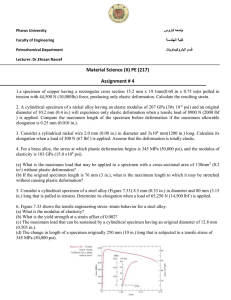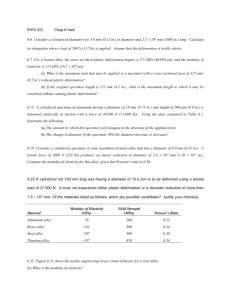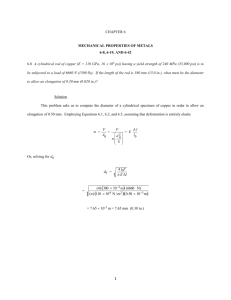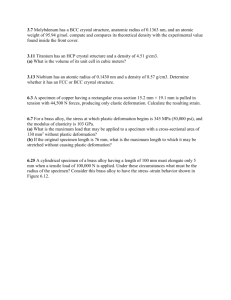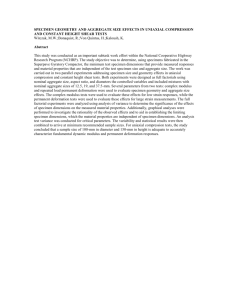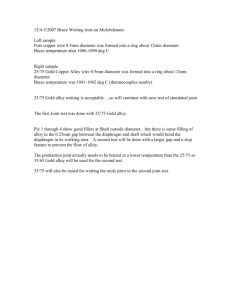pubdoc_2_19600_348
advertisement
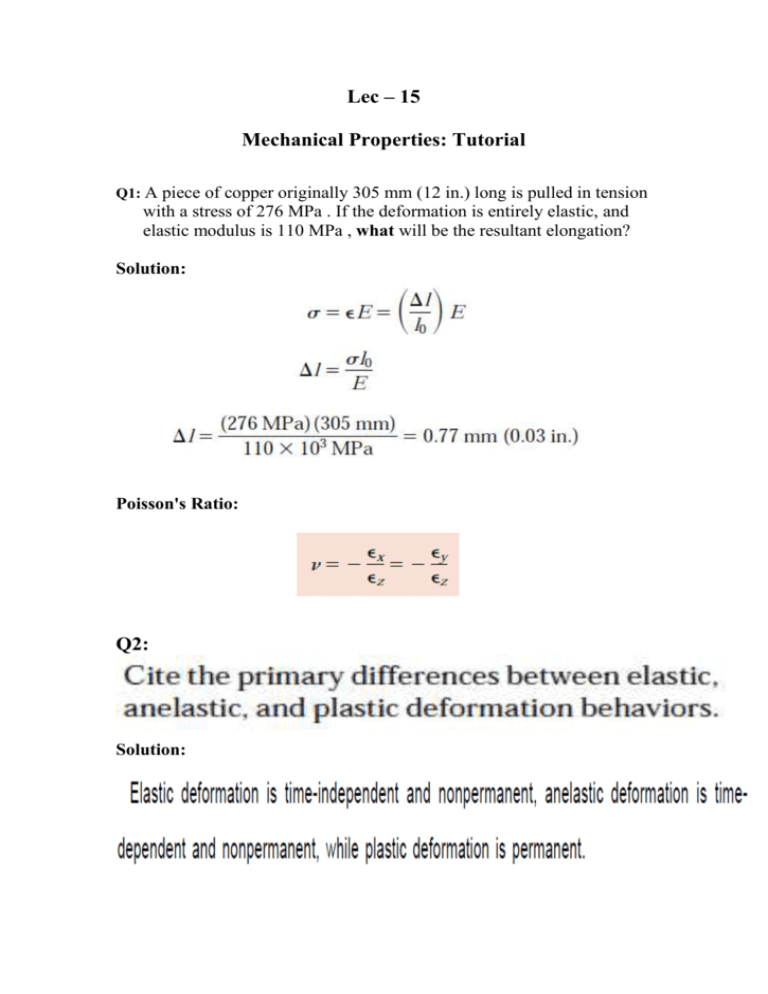
Lec – 15 Mechanical Properties: Tutorial Q1: A piece of copper originally 305 mm (12 in.) long is pulled in tension with a stress of 276 MPa . If the deformation is entirely elastic, and elastic modulus is 110 MPa , what will be the resultant elongation? Solution: Poisson's Ratio: Q2: Solution: Q3: Solution: a- b- Q4: A specimen of aluminum having a rectangular cross section(10mm x 12.7mm) is pulled in tension with 35,500 N force, producing only elastic deformation. Calculate the resulting strain. ( Note : E Al = 69 GPa ) Solution : A0 = 10mm x 12.7mm = 127 mm2 = 1.27 x 10-4m2 Q5: A cylindrical specimen of a titanium alloy having an elastic modulus of 107 GPa and an original diameter of 3.8mm will experience only elastic deformation when a tensile load of 2000 N is applied. Compute the maximum length of the specimen before deformation if the maximum allowable elongation is 0.42mm . Solution : Q6: A steel bar 100mm long and having a square cross section 20mm on an edge is pulled in tension with a load of 89,000 N , and experiences an elongation of 0.10mm. Assuming that the deformation is entirely elastic, calculate the elastic modulus of the steel. Solution : A0 = b0 2 Q7: Consider a cylindrical titanium wire 3.0mm in diameter and 2.5x104mm long. Calculate its elongation when a load of 500 N is applied. Assume that the deformation is totally elastic. ( Note : E Ti = 107GPa ) Solution : Q8: A cylindrical rod of copper (E = 110 GPa) having a yield strength of 240 MPa is to be subjected to a load of 6660 N . If the length of the rod is 380mm , what must be the diameter to allow an elongation of 0.50mm ? Solution : Since, and б = F/A0 ……………(1) б = є E ……………(2) Q9: Consider a cylindrical specimen of a steel alloy (Figure 1) 10mm in diameter and 75mm long that is pulled in tension. Determine its elongation when a load of 23,500 N is applied. Figure 1: Tensile stress-strain behavior of a plain carbon steel Solution : Referring to fig.1: at this stress level , we are in the elastic region on the stress-strain curve, which corresponds to a stain of 0.0013 . Now: Q10: A cylindrical specimen of aluminum having a diameter of 19mm and length of 200mm is deformed elastically in tension with a force of 48,800 N . ( Note : ν Al = 0.33) (a) The amount by which this specimen will elongate in the direction of the applied stress. (b) The change in diameter of the specimen. Will the diameter increase or decrease? Solution : (a): (b): The diameter will decrease Q11: A cylindrical specimen of some alloy 8mm in diameter is stressed elastically in tension. A force of 15,700 N produces a reduction in specimen diameter of 5 x 10-3mm . Compute Poisson’s ratio for this material if its modulus of elasticity is 140 GPa . Solution : Q12: A cylindrical specimen of a hypothetical metal alloy is stressed in compression. If its original and final diameters are 20.000 and 20.025mm, respectively, and its final length is 74.96mm, compute its original length if the deformation is totally elastic. The elastic and shear moduli for this alloy are 105GPa & 39.7GPa, respectively. Solution: Lateral strain єx : In order to determine the longitudinal strain єz , we need Poisson's ratio which may be computed as: Now, єz may be computed as : Now, solving for I0 : Q13: Consider a cylindrical specimen of some hypothetical metal alloy that has a diameter of 8.0mm . A tensile force of 1000 N produces an elastic reduction in diameter of 2.8 x 10-4mm . Compute the modulus of elasticity for this alloy, given that Poisson’s ratio is 0.30. Solution: But: And the transverse strain is: Then: Q14: A cylindrical rod 100mm long and having a diameter of 10.0mm is to be deformed using a tensile load of 27,500 N. It must not experience either plastic deformation or a diameter reduction of more than 7.5 x 10-3mm. Of the materials listed as follows, which are possible candidates? Justify your choice(s). Solution : Relative to the second criterion, it is necessary to calculate the change in diameter ∆d for these two alloys:
